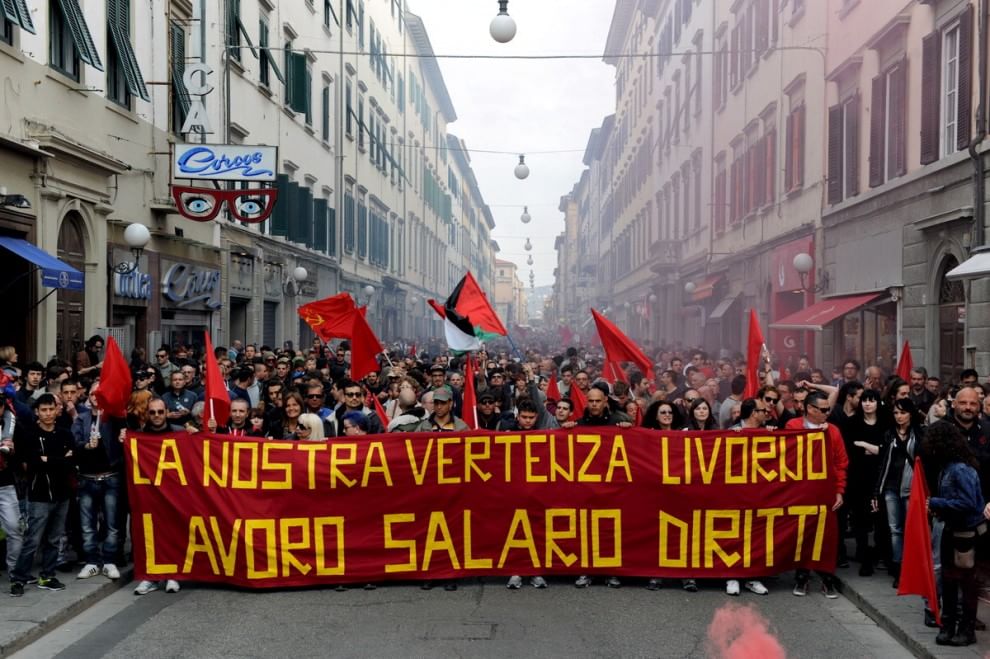A double uselessness: vote or abstain
 Commenting on the results of the elections is very widespread custom in Italy. In times of world cup it could be compared to the simplicity and inconsistency with which many fans criticize the choices of the national football selector. In fact, in both cases, it is hard to spot something clever in a flood of superficial comments and opinions. A good exception to this state of things is what the Clash City Workers have written. In the opening, they rightly highlighted as the success of Matteo Renzi’s Democratic Party has come completely unexpected, at least as regards the size the win has taken. The almost empty squares at the meetings of the Boy Scout of Rignano and the surveys also available in the last two weeks before the election in the form of horse racing, left to assume that the 5 Star Movement was largely regaining and becoming potentially very close to the PD. The counting of votes on Sunday night then handed us a scenario which was simply not assumed on the eve. What this massive injection of legitimacy for the government Renzi can determine from the political point of view, it will be covered in a future article. Here, instead, we will focus only on the data about the turnout of voters. This time, on May 25, it stopped at 58.7%. A result that – in order to be interpreted correctly – deserves to be read in a comparative perspective. It seems important to highlight that: a) in Italy, despite a decline of 7.7 percentage points, voter turnout continues to be among the highest at a continental level, since only in Belgium and Luxembourg (where, however, voting is compulsory) and Malta there were higher percentages; b) the downward trend that since 1979, ie before the first election, had always accompanied the renewal of the European Parliament has been arrested at a continental level (the total participation is in fact increased from 43.0% in 2009 to 43.1% in 2014); c) this result was achieved despite the decrease of the voters in 17 countries and the ongoing complete lack of interest that affects the new member states of the East (for example, only 13.7% of eligible citizens in Slovakia has marked their ballot), while it could be explained by the increase in participation in some, demographically significant countries of the West (Germany +4.6%, France +2.9%, UK +1.5%, Spain +1%); d) in the countries most affected by the current economic crisis, the willingness to go to the polls has been contradictory, given that participation has grown in Greece (+5.6%) and Spain (as already seen), while it has decreased in Portugal (-2.3%) and Ireland (-6.0%), pointing out that there is not a clear relationship between these two variables. In summary, the decrease in participation in Italy should be treated as a relevant factor for both the size that it has taken and the comparison with other European countries, where, instead, there has been a turnround. The fact that we have voted only on Sunday, despite five years ago the polling stations remained open even on Monday, may help to explain some of this decline, which generally relates to the alienation and detachment of society from political élites. It is a shift away that must presumably be interpreted – as it deals with the election of Italian representatives in Europe – even with the presence in Palazzo Chigi of the third government in a row which has come to power without election. Thus leading to the extraordinary contradiction of a hyper-majority law, also declared unconstitutional by the Court, unable to guarantee consistency between the choices of voters and the formation of the government, which was taken as the determining factor to justify the many elements of disproportionality.
Commenting on the results of the elections is very widespread custom in Italy. In times of world cup it could be compared to the simplicity and inconsistency with which many fans criticize the choices of the national football selector. In fact, in both cases, it is hard to spot something clever in a flood of superficial comments and opinions. A good exception to this state of things is what the Clash City Workers have written. In the opening, they rightly highlighted as the success of Matteo Renzi’s Democratic Party has come completely unexpected, at least as regards the size the win has taken. The almost empty squares at the meetings of the Boy Scout of Rignano and the surveys also available in the last two weeks before the election in the form of horse racing, left to assume that the 5 Star Movement was largely regaining and becoming potentially very close to the PD. The counting of votes on Sunday night then handed us a scenario which was simply not assumed on the eve. What this massive injection of legitimacy for the government Renzi can determine from the political point of view, it will be covered in a future article. Here, instead, we will focus only on the data about the turnout of voters. This time, on May 25, it stopped at 58.7%. A result that – in order to be interpreted correctly – deserves to be read in a comparative perspective. It seems important to highlight that: a) in Italy, despite a decline of 7.7 percentage points, voter turnout continues to be among the highest at a continental level, since only in Belgium and Luxembourg (where, however, voting is compulsory) and Malta there were higher percentages; b) the downward trend that since 1979, ie before the first election, had always accompanied the renewal of the European Parliament has been arrested at a continental level (the total participation is in fact increased from 43.0% in 2009 to 43.1% in 2014); c) this result was achieved despite the decrease of the voters in 17 countries and the ongoing complete lack of interest that affects the new member states of the East (for example, only 13.7% of eligible citizens in Slovakia has marked their ballot), while it could be explained by the increase in participation in some, demographically significant countries of the West (Germany +4.6%, France +2.9%, UK +1.5%, Spain +1%); d) in the countries most affected by the current economic crisis, the willingness to go to the polls has been contradictory, given that participation has grown in Greece (+5.6%) and Spain (as already seen), while it has decreased in Portugal (-2.3%) and Ireland (-6.0%), pointing out that there is not a clear relationship between these two variables. In summary, the decrease in participation in Italy should be treated as a relevant factor for both the size that it has taken and the comparison with other European countries, where, instead, there has been a turnround. The fact that we have voted only on Sunday, despite five years ago the polling stations remained open even on Monday, may help to explain some of this decline, which generally relates to the alienation and detachment of society from political élites. It is a shift away that must presumably be interpreted – as it deals with the election of Italian representatives in Europe – even with the presence in Palazzo Chigi of the third government in a row which has come to power without election. Thus leading to the extraordinary contradiction of a hyper-majority law, also declared unconstitutional by the Court, unable to guarantee consistency between the choices of voters and the formation of the government, which was taken as the determining factor to justify the many elements of disproportionality.
If up to now we have offered just a postcard, more or less correct, of the voter turnout in Italy and Europe, certainly the most difficult task is to provide a political reading of the galloping rate of abstention which affects Italy. About that, we have read any kind of interpretation. Some have added non-voting people to the supporters of the Five Star Movement, coming to the astonishing conclusion that the anti-austerity party is the majority in the country; others have simply pointed out how the Democratic Party should deal with the real first force of the country, which is the party of the abstention (sic!), still others have imagined an idyllic situation, or nearly so, for their alleged revolutionary demands (‘sic’ here seems largely wasted!). Certainly a detailed discussion on the necessity to go or not to the polls lies far from the assumptions of this article. However, some short notes can be showed here: a) today the turnout presents itself as a phenomenon of social and generation clear connotations, since the non-participation in voting is higher among the less educated, in the throngs of younger age and lower social strata. This leads to a sinister social homogeneity between voters and elected officials, an event that in past decades was challenged by the enlargement of the suffrage; b) no organized force with some mobilizing capacity has campaigned for non-voting, which, therefore, should be considered a purely individual act, or, in any case, even when as collective behavior, limited to a very narrow circles of activists and acquaintances, absolutely incapable of attracting consensus; c) the single individual act – ticking the ballot paper or deserting the ballot box – has the same, vain, ability to change the present state of things. Maintaining the contrary would justify the liberal vision that considers, on the contrary, individual preferences able to have their own strength and, when added together, able to form the collective will. This naive representation of the political circuit not only does not take into account the different degree of influence and power that individuals from different resources (financial, media, relational) may have in the process, but also – inevitably – it collides with the holistic approach, widely present in Marx’s thought, in which, instead, the final result is something greater and especially different from the sum of individual wills. This is not merely because the analysis shifts from the single individual to broader sectors of society, that is the classes, but also because organized structures and institutional setups matter. Paradoxically, in denying all this the liberal thought and that attributable to the area of autonomy show a remarkable consonance.
In conclusion, we can say that today the phenomenon of abstention, for the traits it has taken on, appears not so much as a form of de-legitimization of the existing structure, but as the immediate and apparent sign of the apathy and de-politicization that runs through our society. Not voting, seen as an individual act, has no value. Just as crossing a symbol on the ballot has no power at all. In fact, nothing exists, in politics, outside the sphere of organization. Then, wondering if a structured and able to gather consensus force should or should not stand for election is a question that deserves an extended discussion and critique. However, it seems superfluous to go into similar disquisitions, when many still don’t realize how indispensable is the need to equip themselves with a political organization worthy of this name.
Read also:























